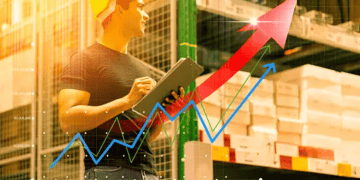Dublin, Oct. 02, 2023 (GLOBE NEWSWIRE) — ResearchAndMarkets.com has added “Green Logistics Market By End Use, By Business Type, By Mode of Operation: Global Opportunity Analysis and Industry Forecast, 2023-2032” to its offerings.
The global Green Logistics Market is poised for substantial growth, with an estimated Compound Annual Growth Rate (CAGR) of 8.3% from 2023 to 2032. This growth is primarily driven by the increasing global focus on environmental regulations and legislation.
Understanding Green Logistics
Green logistics takes a comprehensive approach to minimize the environmental impact associated with logistics operations. It encompasses various sustainable policies and practices aimed at quantifying and reducing ecological consequences related to the movement of products, information, and services. The primary objective of green logistics is to enhance operational efficiency while giving priority to sustainability. This includes initiatives to reduce emissions, adopt eco-friendly operational processes, and mitigate environmental pollution.
Sustainability in Transportation
Green logistics places a significant emphasis on optimizing transportation activities to reduce fuel consumption and emissions. Key strategies include the use of fuel-efficient vehicles, modal shifts (e.g., from road transport to rail or water transport), and route optimization techniques. Additionally, it embraces alternative fuel technologies such as electric or hybrid vehicles and sustainable aviation fuel (SAF) for air transport.
Commitment of the Automotive Sector
The automotive sector plays a pivotal role in the green logistics landscape, as manufacturers adopt eco-friendly logistic approaches to minimize their carbon footprint. For instance, Ford recently joined Manufacture 2030, a platform for carbon emissions measurement, management, and mitigation across industries, as part of its commitment to achieving carbon neutrality by 2050. By extending these efforts throughout its supply chain, including tier suppliers and logistics services, Ford aims to reduce emissions across its operations.
Impact on Banking and Financial Services
The banking and financial services sector is also influenced by green logistics due to the expansion of bank branch networks and the widespread adoption of information technology, which has increased demand for logistics services. Financial institutions are integrating eco-friendly logistics practices, supported by governments and banks providing loans for green logistics projects. For example, the Commonwealth Bank of Australia introduced green asset finance solutions to facilitate investments in green vehicles, equipment, and machinery, enabling businesses to make environmentally conscious choices.
Growth in Roadways Distribution
Roadways distribution logistics is experiencing growth due to its lower capital investment compared to other transportation modes, leading to the emergence of new companies in the market. The adoption of electric vehicles (EVs) in logistics, driven by the growing e-commerce industry and door-to-door delivery services, is boosting the green logistics market in the roadways distribution segment. Major logistics companies are transitioning to EVs to reduce carbon emissions.
Technological Advancements
The adoption of transportation management software is on the rise, with smart warehouses incorporating advanced technologies and automation systems to optimize operations and enhance energy efficiency. Additionally, logistics companies are increasingly focused on implementing eco-friendly practices, including the utilization of renewable materials, proper waste management systems, and energy-efficient solutions.
Market Segmentation
The green logistics market is segmented as follows:
End Use: Healthcare, manufacturing, automotive, banking and financial services, retail and e-commerce, and others. Business Type: Warehousing, distribution, and value-added services. Mode of Operation: Storage, roadways distribution, seaways distribution, and others. Region: North America (U.S., Canada, Mexico), Europe (Germany, France, Russia, UK, rest of Europe), Asia-Pacific (China, Japan, India, South Korea, rest of Asia-Pacific), and LAMEA (Latin America, Middle East, Africa). Key Market Insights
The manufacturing segment is the highest revenue contributor, estimated to reach $817.09 billion by 2032, with a CAGR of 7.7%. The distribution segment is the highest revenue contributor by business type, estimated to reach $1,701.45 billion by 2032, with a CAGR of 8.6%. The storage segment dominates the mode of operation, estimated to reach $451.08 billion by 2032, with a CAGR of 7.6%. However, the seaways distribution segment is expected to grow the fastest, with a CAGR of 9.2%. Regional Highlights
North America leads the green logistics market, with a focus on sustainable practices driven by environmental regulations and awareness of carbon footprint reduction. The U.S. is particularly taking significant steps toward sustainability, with private logistics companies investing in sustainable logistic projects. Canada and Mexico are also making strides in adopting green logistics practices, with a focus on alternative fuels and efficient supply chain management.
Key Market Players
Key players in the green logistics market include Agility Public Warehousing Company K.S.C.P. and Subsidiaries, Bolloré SE, CEVA Logistics, Deutsche Post DHL Group, DSV, FedEx Corporation, GEODIS, United Parcel Service of America, Inc., XPO Logistics, Inc., and Yusen Logistics Co., Ltd.
Market Dynamics
Drivers:
- Increased CSR Activities by Logistic Companies
- Surge in Adoption of EVs in the Logistics Industry
- Implementation of Stringent Environmental Regulations
- Increase in Adoption of Artificial Intelligence in the Global Logistics Industry
Restraints:
- Lack of Infrastructure
- Dependency on Fossil Fuels for Transportation
- High Costs of Implementing Green Procurement Practices Discourage Potential Investors
Opportunities:
- Surge in Demand for Smart Green Warehouses
- Increased Environmental Consciousness Among End-Use Industries
- Development of LiDAR Drones for Last-Mile Delivery and Warehouses
Get the latest supply chain logistics news updates at The Supply Chain Report. Visit ADAMftd.com for free tools related to international trade.
#GreenLogisticsMarket #SustainableTransport #EcoFriendlyLogistics #CarbonNeutralGoals #ElectricVehiclesInLogistics #GreenWarehouseTech #EnvironmentalSustainability #LogisticsIndustryTrends #SmartWarehousing #TransportationInnovation #GreenAssetFinance #CSRInLogistics #ClimateConsciousTransport #SustainableDistribution #LogisticsTechAdvances #EVAdoption #SmartGreenWarehouses

















